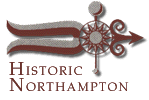
Bridge Street Cemetery Northampton Architecture Historic Markers 
|


About 18th Century Gravestones
It was not until the 1720's that images began to appear in Bridge Street: the winged death's head. A late example of this style would be Lieutenant Jonathan Hunt's grave from 1769. The death's head symbolized the certainty and triumph of death, as well as God's judgement of sin. This representational image was a dramatic break from the graves of before, and was part of a Puritan movement towards symbolic representation of spirituality. As the Puritan control weakened, the cherub motif began to evolve from the Death's head. The cherubs are less didactic and ominous than the skulls, and suggest an emphasis on heaven and salvation, rather than judgement. These appeared in Bridge Street in the 1750's brought by Northampton's most well known stone cutter, Nathaniel Phelps. Graves began to have decorative motifs and epitaphs about the deceased's life. The phrase "in memory of" began to be used over "here lies", suggesting the individual value of the person, rather than the value the community had of them. A late and uncommon example of Phelps work can be seen with the grave of Seth Pomeroy, 1777. An example of a decorative cherub motif possibly done by Phelps is that of Captain James Lyman, 1769. An example of the changing epitaph can be seen in the stone of Mrs. Phebe Pomeroy.
Contents Historic Northampton.